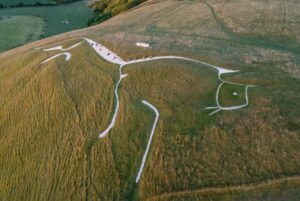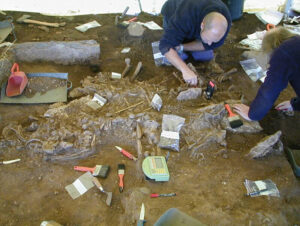A goldsmith’s body found near Stonehenge had more treasure — and history — than researchers initially realized.
In 2021, archaeologists unearthed new finds on the site of a proposed new road tunnel at Stonehenge.
Now Cambridge University researchers have discovered that a set of polished rocks found in a grave were actually goldsmithing tools, according to a paper published in the journal Antiquity last week.
The scientists conducted microscopic analysis of axes and shaped cobbles found in the grave. That showed them tiny traces of gold and wear marks on the “lumps of stone” used by a craftsperson to create sheets of gold.

Hammers and anvils from an ancient goldsmith. Photo: Wiltshire Museum/Devizes
This bronze age burial mound was originally excavated in 1802 near Upton Lovell in Wiltshire. Early on, the site received notoriety for its large collection of pierced animal bones. Scientists and historians believe that these decorative bones served as the adornments of a shaman.
Scientists have dated the grave’s items to between 1850-1700 BC. They likely came from the Wessex culture, which followed the civilization that built nearby Stonehenge.
The gold worker “is definitely special,” Oliver Harris, an associate professor of archaeology at the University of Leicester, told The Guardian. “The way they dress, they have materials that are thousands of years old –- they’re going to be someone who stands out. This is a person who dresses very differently from some of their compatriots.”

Examples of the Neolithic axes discovered near Stonehenge. Photo: Wiltshire Museum/Devizes
Ancient battle axes
The grave’s artifacts also included flint cups, two broken battle axes, and a copper alloy awl.
But it’s the axes that received the most attention, for good reason.
The four Neolithic axes were actually several thousand years old when buried with the gold worker. Analysis showed that one of them had even been used to prepare Bronze Age gold.
“I would love to know whether they are heirlooms that have been handed down through generations, or whether they were deposited in rivers and were found alongside the cobbles that have been turned into these stone tools –- or maybe alongside the gold itself,” Harris explained.






